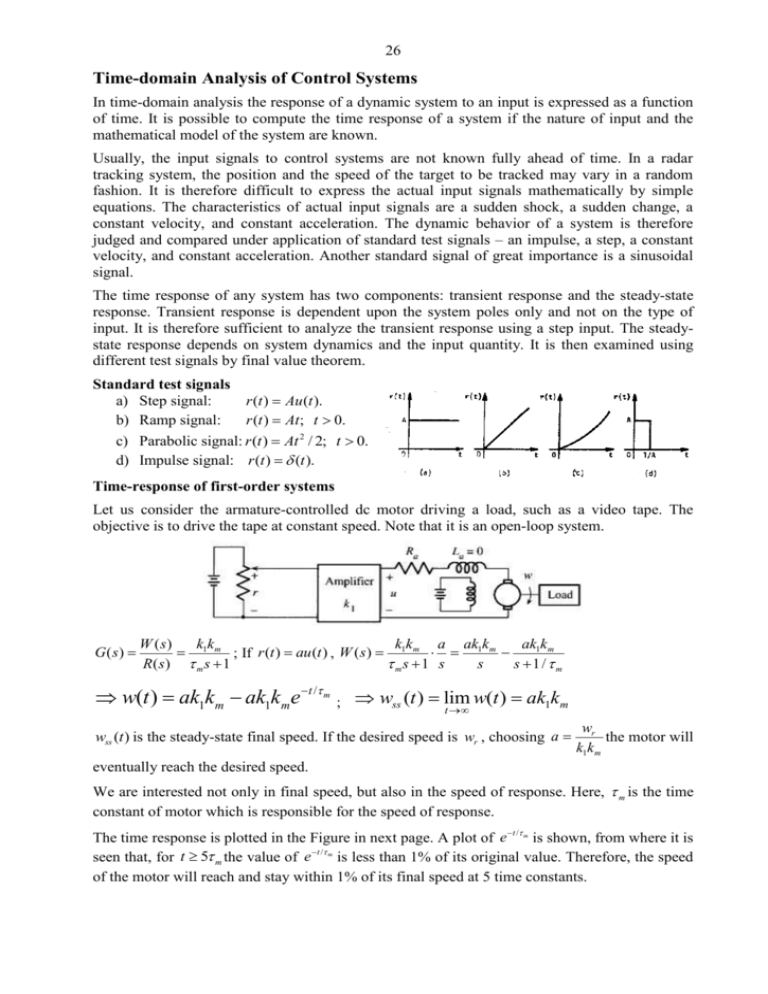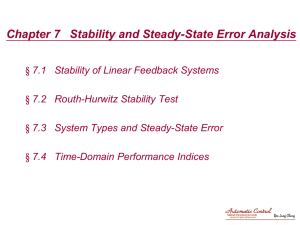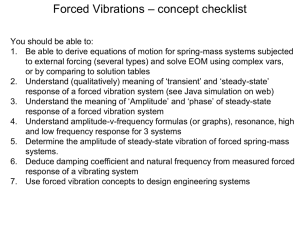Time-domain Analysis of Control Systems
advertisement

26
Time-domain Analysis of Control Systems
In time-domain analysis the response of a dynamic system to an input is expressed as a function
of time. It is possible to compute the time response of a system if the nature of input and the
mathematical model of the system are known.
Usually, the input signals to control systems are not known fully ahead of time. In a radar
tracking system, the position and the speed of the target to be tracked may vary in a random
fashion. It is therefore difficult to express the actual input signals mathematically by simple
equations. The characteristics of actual input signals are a sudden shock, a sudden change, a
constant velocity, and constant acceleration. The dynamic behavior of a system is therefore
judged and compared under application of standard test signals – an impulse, a step, a constant
velocity, and constant acceleration. Another standard signal of great importance is a sinusoidal
signal.
The time response of any system has two components: transient response and the steady-state
response. Transient response is dependent upon the system poles only and not on the type of
input. It is therefore sufficient to analyze the transient response using a step input. The steadystate response depends on system dynamics and the input quantity. It is then examined using
different test signals by final value theorem.
Standard test signals
r (t ) Au (t ).
a) Step signal:
r (t ) At ; t 0.
b) Ramp signal:
c) Parabolic signal: r (t ) At 2 / 2; t 0.
d) Impulse signal: r (t ) (t ).
Time-response of first-order systems
Let us consider the armature-controlled dc motor driving a load, such as a video tape. The
objective is to drive the tape at constant speed. Note that it is an open-loop system.
G ( s)
kk
kk
ak1km
W ( s)
a ak k
1 m ; If r (t ) au (t ) , W ( s ) 1 m 1 m
R( s) m s 1
ms 1 s
s
s 1/ m
w(t ) ak1km ak1kme t / m ; wss (t ) lim w(t ) ak1km
t
wss (t ) is the steady-state final speed. If the desired speed is wr , choosing a
wr
the motor will
k1k m
eventually reach the desired speed.
We are interested not only in final speed, but also in the speed of response. Here, m is the time
constant of motor which is responsible for the speed of response.
The time response is plotted in the Figure in next page. A plot of e t / m is shown, from where it is
seen that, for t 5 m the value of e t / m is less than 1% of its original value. Therefore, the speed
of the motor will reach and stay within 1% of its final speed at 5 time constants.
27
Figure: Time responses
Let us now consider the closed-loop system shown below.
Here, T ( s )
k1km / ( m s 1)
k1km
kk
W (s)
1 o
R( s ) 1 k1k2 km / ( m s 1) m s (1 k1k2 km ) o s 1
where, ko
km
m
and o
.
1 k1k2 km
1 k1k2 km
If r (t ) a , the response would be, w(t ) ak1ko ak1ko e
t / o
.
If a is properly chosen, the tape can reach a desired speed. It will reach the desired speed in
5 o seconds. Here, o m . Thus, we can control the speed of response in feedback system.
Although the time-constant is reduced by a factor (1 k1k2 km ) , in the feedback system, the motor
gain constant is also reduced by the same factor. In order to compensate for this loss of gain, the
applied reference voltage must be increased by the same factor.
Ramp response of first-order system
Let, k1k0 1 for simplicity. Then, T ( s )
1
W ( s)
. Also, let, r (t ) tu (t ) .
o s 1 R( s)
28
Then, W ( s)
o2
1
1 o
;
s 2 ( o s 1) s 2 s o s 1
w(t ) tu (t ) o (1 e t / o )u (t )
The error signal is, e(t ) r (t ) w(t )
Or, e(t ) o (1 e t / o )u (t )
ess (t ) o
Thus, the first-order system will track the unit ramp input with a steady-state error o , which is
equal to the time-constant of the system.
Time-response of second-order systems
Consider the antenna position control system. Its transfer function from r to y is,
T ( s)
k1k2 km
k1k2 km / m
n2
Y (s)
R( s) m s 2 s k1k2 km s 2 1 s k k k /
s 2 2n s n2
1 2 m
m
m
n2 k1k2 km / m and 2n
1
. The constant is called the damping
m
ratio and n is called the natural frequency. The system above is in fact a standard second order
system.
where, we define,
The transfer function T ( s ) has two poles and no zero. Its poles are,
s1 , s2 n jn 1 2 jd .
29
Here, is called the damping factor, d is called damped or actual frequency.
The location of poles for different are plotted in Figure below. For 0 , the two poles jn
are purely imaginary. If 0 1 , the two poles are complex conjugate. All possible cases are
described in a table shown below.
Natural frequency, n
The natural frequency of a second order system is the frequency of oscillation of the system
without damping.
Damping ratio,
The damping ratio is defined as the ratio of the damping factor, to the natural
frequency n .
b
T ( s) 2
Suppose,
.
s as b
Comparing with standard equation, a 2n and n2 b .
Unit step response of second-order systems
n2
s 2n
1
1
1
Suppose, r (t ) u (t ), R ( s ) ; Y ( s) 2
2
2
s
s s 2n s n s s 2n s n2
Or,
s 2n
s n n
1
1
Y ( s)
2
2
2
s ( s n ) n (1 ) s ( s n ) 2 (n 1 2 ) 2
Performing inverse Laplace transform,
y (t ) 1 e nt cos(n 1 2 )t e nt sin(n 1 2 )t
or, y (t ) 1
or, y (t ) 1
or, y (t ) 1
1 2
ent
1 2 cos(n 1 2 )t sin(n 1 2 )t
2
1
ent
1
2
sin(d t ) ,where, d n 1 2 and tan 1
1 2 / cos 1
n t
e sin(d t ) ……………………………………………………….(01)
d
30
The plot of e t sin(d t ) is shown in Figure.
The steady-state response is,
yss (t ) lim y (t ) 1
t
Thus, the system has zero steady-state error.
The pole of T ( s ) dictates the response,
e t sin(d t ) .
The response y (t ) for different is shown in Figure below.
Time response specifications
Control systems are generally designed with damping less than one, i.e., oscillatory step
response. Higher order control systems usually have a pair of complex conjugate poles with
damping less than unity that dominate over the other poles. Therefore the time response of
second- and higher-order control systems to a step input is generally of damped oscillatory
nature as shown in Figure next (next page).
In specifying the transient-response characteristics of a control system to a unit step input, we
usually specify the following:
1. Delay time, t d
2. Rise time, tr
3. Peak time, t p
4. Peak overshoot, M p
5. Settling time, ts
6. Steady-state error, ess
31
1. Delay time, t d : It is the time required for the response to reach 50% of the final value in first
attempt.
2. Rise time, tr : It is the time required for the response to rise from 0 to 100% of the final value
for the underdamped system.
3. Peak time, t p : It is the time required for the response to reach the peak of time response or
the peak overshoot.
4. Settling time, ts : It is the time required for the response to reach and stay within a specified
tolerance band ( 2% or 5%) of its final value.
5. Peak overshoot, M p : It is the normalized difference between the time response peak and the
steady output and is defined as,
c(t ) c()
%M p p
100%
c ( )
6. Steady-state error, ess : It indicates the error between the actual output and desired output as
‘t’ tends to infinity.
ess lim[r (t ) c(t )] .
t
Let us now obtain the expressions for the rise time, peak time, peak overshoot, and settling time
for the second order system.
1. Rise time, tr : Put y (t ) 1 at t tr , sin(d tr ) 0 sin , tr
2. Peak time, t p : Put
; cos 1 .
d
n t
dy
0 and solve for t t p ; 0
e sin(d t ) n e t cos(d t ) .
dt
d
tan(d t p )
1 2
d n 1 2
tan , d t p k
n
Peak overshoot occurs at k = 1. t p / d / n 1 2 .
3. Settling time, ts : For 2% tolerance band,
n t
4
e
0.02 , t s 4T .
d
s
k 0,1, 2,
32
4. Steady-state error, ess : It is found previously that steady-state error for step input is zero.
Let us now consider ramp input, r (t ) tu (t ) .
n2
1 1
Then, ess lim s{R( s ) Y (s )} lim s{ 2 2 2
}
s 0
s 0
s s s 2n s n2
2
2
2
n2
1
1 s 2n s n n
ess lim {1 2
} lim
2
2
s 0 s
s 0 s
s 2n s n2
s 2n s n
2
Therefore, the steady-state error due to ramp input is
.
n
2
2
n
.
2
n
n
Steady-state error and error constants
The steady-state performance of a stable control system is generally judged by its steady-state
error to step, ramp and parabolic inputs. For a unity feedback system,
E (s)
R( s)
sR( s)
, ess lim sE ( s) lim
.
s 0
s 0 1 G ( s )
1 G ( s)
It is seen that steady-state error depends upon the input R( s ) and the forward transfer
function G ( s ) . The steady-state errors for different inputs are derived as follows:
1. For unit-step input: r (t ) u (t ), R( s )
1
s
1
1
1
; k p is called position error constant.
s 0
s 0 1 G ( s )
1 G(0) 1 k p
1
2. For unit-ramp input: r (t ) tu (t ), R ( s ) 2
s
1
1
1
ess lim sE (s) lim
lim
; kv is called velocity error constant.
s 0
s 0 s 1 G ( s )
s 0 sG ( s )
kv
1
3. For unit-parabolic input: r (t ) t 2 / 2, R( s ) 3
s
1
1
1
ess lim sE (s) lim 2
lim 2
; ka is called acceleration error const.
s 0
s 0 s 1 G ( s )
s 0 s G ( s )
ka
ess lim sE (s) lim
Types of Feedback Control System
The open-loop transfer function of a system can be written as,
G( s)
K (s z1 )(s z2 )(s z3 )
s n (s p1 )(s p2 )(s p3 )
K (Tz1s 1)(Tz 2 s 1)(Tz 3s 1)
s n (Tp1s 1)(Tp 2 s 1)(Tp 3s 1)
If n = 0, the system is called type-0 system, if n = 1, the system is called type-1 system, if n = 2,
the system is called type-2 system, etc. Steady-state errors for various inputs and system types
are tabulated below.
33
The error constants for non-unity feedback systems may be obtained by replacing G(s) by
G(s)H(s). Systems of type higher than 2 are not employed due to two reasons:
1. The system is difficult to stabilize.
2. The dynamic errors for such systems tend to be larger than those
types-0, -1 and -2.
Effect of Adding a Zero to a System
Let a zero at s = -z be added to a second order system. Then we have,
( s z )n2 / z
n2
n2
C (s)
s
2
.
R(s) s 2n s n2 s 2 2n s n2 z s 2 2n s n2
The multiplication term is adjusted to make the steady-state gain of the system unity. This gives
css = 1 when the input is unit step. Let cz(t) be the response of the system given by the above
equation and c(t) is the response without adding the pole. Manipulation of the above equation
gives,
1 d
cz (t ) c(t )
c(t ).
z dt
The effect of added derivative term is to produce a pronounced early peak to the system
response which will be clear from the figure in the next page. Closer the zero to origin, the more
pronounce the peaking phenomenon. Due to this fact, the zeros on the real axis near the origin
are generally avoided in design. However, in a sluggish system the artful introduction of a zero
at the proper position can improve the transient response. We can see from equation (03) that as
z increases, i.e., the zero moves further into the left half of the s-plane, its effect becomes less
pronounced.
Design Specifications of Second-order Systems
A control system is generally required to meet three time
response specifications: steady-state accuracy, damping factor
(or peak overshoot, Mp) and settling time ts. Steady-state
accuracy requirement is met by suitable choice of Kp, Kv, or Ka
depending on the type of the system. For most control systems
in the range of 0.7 – 0.28 (or peak overshoot of 5 – 40%) is
considered acceptable. For this range of , the closed-loop pole
locations are restricted to the shaded region of the s-plane as
shown in Figure.
34
For the antenna position control system, n k1k2 km / m ;
1
2
; ts
4
.
2n m
n
n
Here, k2 is only the adjustable parameter. If we increase k2 , n will increase and thus settling
time will decrease. At the same time, will decrease, this indicates the increase in peak
overshoot. Thus by merely increasing gain, we cannot improve both transient and steady-state
error specifications. We need to add additional components to the system. These are called
compensators. It will allow improvement of both transient and steady-state specifications.
Example 1: Derivative Error Compensation
; ess
ramp






